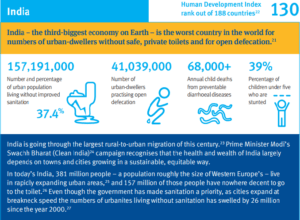In 2013, The United Nations dedicated November 19th to observe World Toilet Day– in a bid to focus the attention towards better hygiene and sanitation amongst the developing countries. Considering the widespread development that countries have achieved in the socio-economic front, there is much left to be desired on the hygiene and sanitation areas.
WaterAid Report
Water Aid, a UK-based charity organization working towards providing people access to safe water, sanitation and hygiene. According to a latest report published by Water Aid that is titled- “Overflowing Cities: State of the World’s Toilets 2016”, India tops the list for the maximum number of urbanites living without sanitation. The report cites- “Economic development and urban planning have not kept pace with the sheer volumes of people arriving – and being born – every day in towns and cities.”
Infographic courtesy: WaterAid UK
World Bank Report 2013
A World Bank Report in 2013, regarding the same titled “Effects of Early Life exposure to Sanitation on Childhood Cognitive Skills: Evidence from India’s Total Sanitation Campaign” penned by Dean Spears and Sneha Lamba that was released highlights few major scenarios on this brewing topic.
“53% of Indian Households i.e. over 600 million people in India defecate without a proper toilet or a latrine”- the report reveals. Researching extensively on the topic the report states the detrimental effects of widespread open defecation in developing countries on cognitive skills among children. According to the report- the TSC- Total Sanitation Campaign- a flagship program of the Indian Government was instrumental in improving rural sanitation. But a lot is still left to be desired.
On the event of the World Toilet Day, many NGOs and Municipal Corporations have joined hands and are conducting various Public talks and campaigns to stress the need for better sanitation and toilet facilities across the state and country.
Right to Sanitation Campaign
RTS- Right to Sanitation Campaign that is launched to drive home the point regarding better sanitation and hygiene requirements in the country released a dossier that elaborates the situation elaborately. According to the report, the census of 2011 in India shows a staggering fact that only 31.9% households in rural India have access to sanitation. The report highlights various statistics and presents a shocking revelation wherein the Ministry of Drinking Water and Sanitation claims that 53.09% od rural India was covered in toilet drive conducted in 2010 end. But this clashes with the data arrived from the census and shows serious gaps between the data on coverage and data on actual reality.
We Can’t Wait
Another report- titled- “We Can’t Wait”– jointly collaborated by Unilever Domestos, WaterAid and Water Supply & Sanitation Collaborative Council (WSSCC) was presented at the United Nations event in New York and explains the crisis at a global level. This is the first time the three organizations representing the world of business, UN & NGOs have come together to handle a case of such importance. The report explains in detail about the global sanitation crisis with adequate data and the perils of ignoring the same. Also-an elaborate analysis of the impact of poor sanitation on women’s health paints a gloomy picture. Some of the conclusions and recommendations of the 28-page report are as follows:
*The UN Member States are urged to consider a dedicated goal on water and sanitation that sets ambitious targets to achieve universal access to water, sanitation and hygiene so that:
– no one practices open defecation
-everyone has safe water, sanitation and hygiene at home
-all schools and health facilities have safe water, sanitation & hygiene
-water, sanitation and hygiene are sustainable and inequalities in access have been progressively eliminated.
The situation is indeed gloomy and we could end up with even more dire consequences if immediate action is not taken. Government along with the help of NGOs and Corporate World would have to join hands together to save the nation from this predicament.
Awareness holds the key and educating the children in school and the women in Rural India would help a long way and set right the level of hygiene and sanitation in the country.
Pic courtesy: prezi.com

